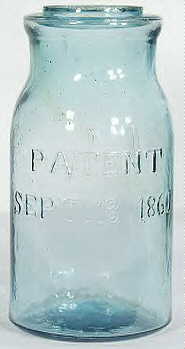
On September 18, 1860 Robert Hemingray received patent No. 30,063 for a "Mold for Glass Jars". This patent is found on some early wax seal jars - An example is shown below (Photo courtesy Greg Spurgeon)

On June 9, 1863 Ralph Gray and Robert Hemingray receive patent No. 38,820 "Improvements in Caps for Fruit Jars".
Ralph Gray died on November 30, 1863 leaving Robert Hemingray as the administrator for his will. The will expressed his concern for the “distracted condition” of the country and included instructions for Robert to dispose of his half interest in the glass works for the benefit of his widow, Ann Gray. Ralph and Ann had no children of their own, however, they raised the sons and daughters of his brother, James Gray of Pittsburgh, Pennsylvania. Ralph and Ann are buried in Spring Grove Cemetery, Cincinnati, Ohio.
On February 15th, 1864 Robert Hemingray, as executor of Ralph Gray’s estate, sold Ralph Gray’s undivided one-half interest in the “Covington Glass Works” to Richard Evans, Samuel J. Hemingray, James L. Foley, and Joseph C. Hemingray. Richard Evans was married to Mary Jane Hemingray, the youngest sister of Robert, Samuel, and Joseph Hemingray. Joseph C. Hemingray, a younger brother of Robert, was an attorney and banker in Levanworth, Kansas, at the time. James L. Foley was the Provost Marshall of Kenton County, Kentucky, early in the Civil War. He was subsequently assigned to a calvary unit in Kansas, and had just returned to Covington at the time of this settlement of Ralph Gray’s estate. With the exception of Foley’s one-eight interest, the glass works was then in the hands of the Hemingray family.
On February 16th, 1864 W. Webster, of Middletown, Ohio, received Patent No. 41,657. This fruit jar was manufactured and marketed by the Hemingray Brothers and Company.
On April 27, 1865 Anthony Gray, glass blower and brother of Ralph Gray, died in Covington, Kentucky. He left a widow and four children. The children were raised by their uncle, Robert Hemingray, in his household. Anthony and Susan Gray are buried in Linden Grove Cemetery, Covington, Kentucky.
On June 9th, 1865 Joseph C. Hemingray sold his one-eight interest in the glass works to Robert Hemingray. He was never again involved with the glass works.
On June 27th 1865 Robert Hemingray received Patent No. 48,399: “Improved Fruit Jar.”
On September 9th, 1866 Samuel J. Hemingray died, creating another crises for the owners of the glass works. Samuel’s widow, Ann Hemingray, sold his one-eighth interest in the glass works to a William Jones (there is a possibility that William Jones may have been Ann’s brother). William Jones, in turn, sold the interest to Richard Evans and James L. Foley at a considerable profit. Ann Hemingray left Covington and moves to Newark, Ohio, where she lived until her death on 16 November 1879. Samuel and Ann had three children, a son and two daughters. It is know that the daughters left Newark and moved to Pittsburgh, Pennsylvania, presumably to live with relatives. It is unknown what became of the son.
Thanks to Glenn Drummond for this and much more Hemingray historical information included in this timeline.